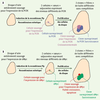| dc.contributor.author | Albagli, Olivier | - |
| dc.contributor.author | Pelczar, Hélène | - |
| dc.date.accessioned | 2014-07-03T06:51:24Z | |
| dc.date.available | 2014-07-03T06:51:24Z | |
| dc.date.issued | 2006 | fr_FR |
| dc.identifier.citation | Albagli, Olivier ; Pelczar, Hélène ; Myc et compétitions intercellulaires chez la drosophile, Med Sci (Paris), 2006, Vol. 22, N° 6-7; p. 621-625 ; DOI : 10.1051/medsci/20062267621 | fr_FR |
| dc.identifier.issn | 1958-5381 | fr_FR |
| dc.identifier.uri | http://hdl.handle.net/10608/5816 | |
| dc.description.abstract | La différenciation cellulaire repose en partie sur des mécanismes de sélection, notamment par compétition vis-à-vis de facteurs extrinsèques vitaux présents en quantité limitante ; mais quels sont les déterminants internes gouvernant l’aptitude des cellules dans ce type de compétition ? De récents travaux menés sur le disque imaginal de l’aile de drosophile en identifie un, la protéine d-Myc. En effet, le niveau relatif d’expression de d-Myc par les cellules de cet épithélium détermine l’issue de leur compétition, les cellules les mieux pourvues tendant à surcroître, au détriment de leur voisines qui disparaissent par apoptose. Un niveau relativement élevé de d-Myc confère donc un avantage compétitif décisif, probablement en stimulant la biogenèse des ribosomes, ce qui augmenterait la capacité des cellules à recevoir, voire à accaparer, des facteurs extrinsèques vitaux, en particulier Dpp (decapentaplegic). Ces résultats pourraient expliquer comment une surexpression des protéines Myc de vertébrés contribue à la tumorigenèse et, par conséquent, éclairer les liens unissant métabolisme et cancer. | fr |
| dc.description.abstract | Cell differentiation and organ shaping proceed not only upon instructive but also upon competitive cell-cell interactions. In the proliferating epithelium forming the larval Drosophila wing disc, cell competition contributes to the fidelity of the organogenesis. Several recent studies show how d-myc, encoding a bHLH/LZ transcription factor homologous to vertebrate Myc proteins, controls cell competition during wing development. In this model, any experiment leading to the confrontation of two populations differing by their levels of d-Myc expression, even in a two-fold ratio, gives rise to a competition characterized both by an overgrowth of the population having the highest level and an apoptotic elimination of the neighbouring « weakly » expressing cells. As a consequence of the mutually compensating nature of these two processes, the final size of the wing remains unchanged. Importantly, lowering or elevating d-Myc expression to the same extent in all cells of the disc does not trigger competition. This indicates that competition is linked to a spatial heterogeneity in, and not to the absolute level of, d-Myc expression. Both vertebrate and Drosophila Myc proteins stimulate ribosome biogenesis, and genetic evidence in Drosophila suggests that this property underlies the strong competitive advantage imparted by its relatively high expression. Accordingly, it is proposed, although not proved, that the more the wing cells express d-Myc and amplify their protein synthesis apparatus, the more they bind, internalize, and transduce the vital and limiting growth factor Dpp, which in turn is presumed to increase d-Myc protein level. These findings suggest that wing organogenesis is a self-corrected process whereby d-Myc induction in overgrowing cells ensures the compensatory elimination of their neighbours. Moreover, they have important implications for the oncogenic role of vertebrate Myc proteins and possibly of related transcription factors.◊ | en |
| dc.language.iso | fr | fr_FR |
| dc.publisher | EDK | fr_FR |
| dc.relation.ispartof | M/S revues | fr_FR |
| dc.relation.haspart | Erratum, Med Sci (Paris), 2006, Vol. 22, N° 8-9; p. 695 ; DOI : 10.1051/medsci/20062289695 ; http://www.ipubli.inserm.fr/handle/10608/5834 | fr_FR |
| dc.rights | Article en libre accès | fr |
| dc.rights | Médecine/Sciences - Inserm - SRMS | fr |
| dc.source | M/S. Médecine sciences [ISSN papier : 0767-0974 ; ISSN numérique : 1958-5381], 2006, Vol. 22, N° 6-7; p. 621-625 | fr_FR |
| dc.subject.mesh | Animaux | fr |
| dc.subject.mesh | Reproduction sélective | fr |
| dc.subject.mesh | Division cellulaire | fr |
| dc.subject.mesh | Drosophila | fr |
| dc.subject.mesh | Régulation de l'expression des gènes | fr |
| dc.subject.mesh | Protéines du proto-oncogène c-myc | fr |
| dc.subject.mesh | Vertébrés | fr |
| dc.title | Myc et compétitions intercellulaires chez la drosophile | fr |
| dc.type | Article | fr_FR |
| dc.contributor.affiliation | Inserm U790, PR1, Institut Gustave Roussy, 39, rue Camille Desmoulins, 94805 Villejuif, France | fr_FR |
| dc.contributor.affiliation | CNRS/Université Paris VI, UMR 7622, 7, quai Saint Bernard, 75005 Paris, France | fr_FR |
| dc.identifier.doi | 10.1051/medsci/20062267621 | fr_FR |
| dc.identifier.pmid | 16828038 | fr_FR |






